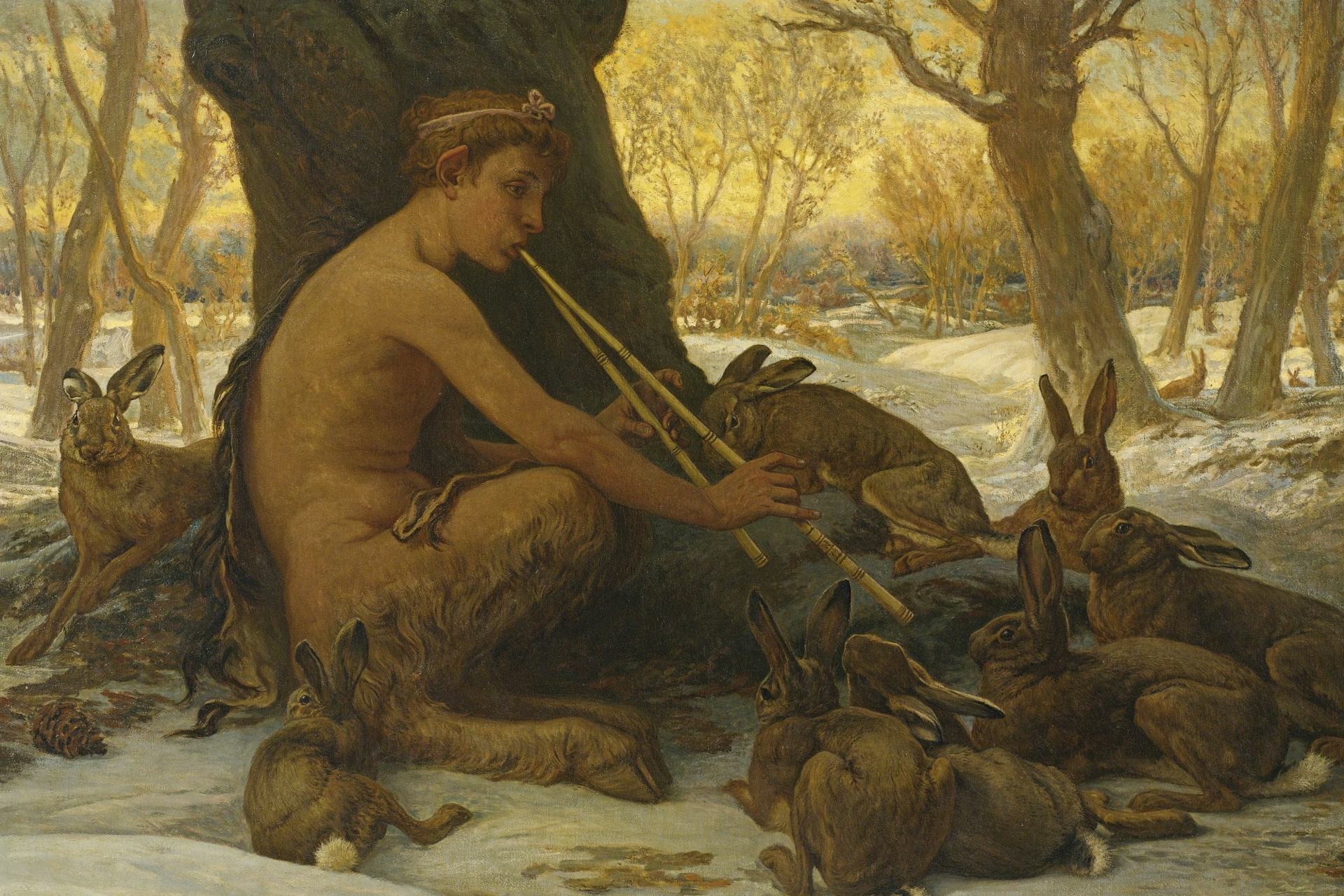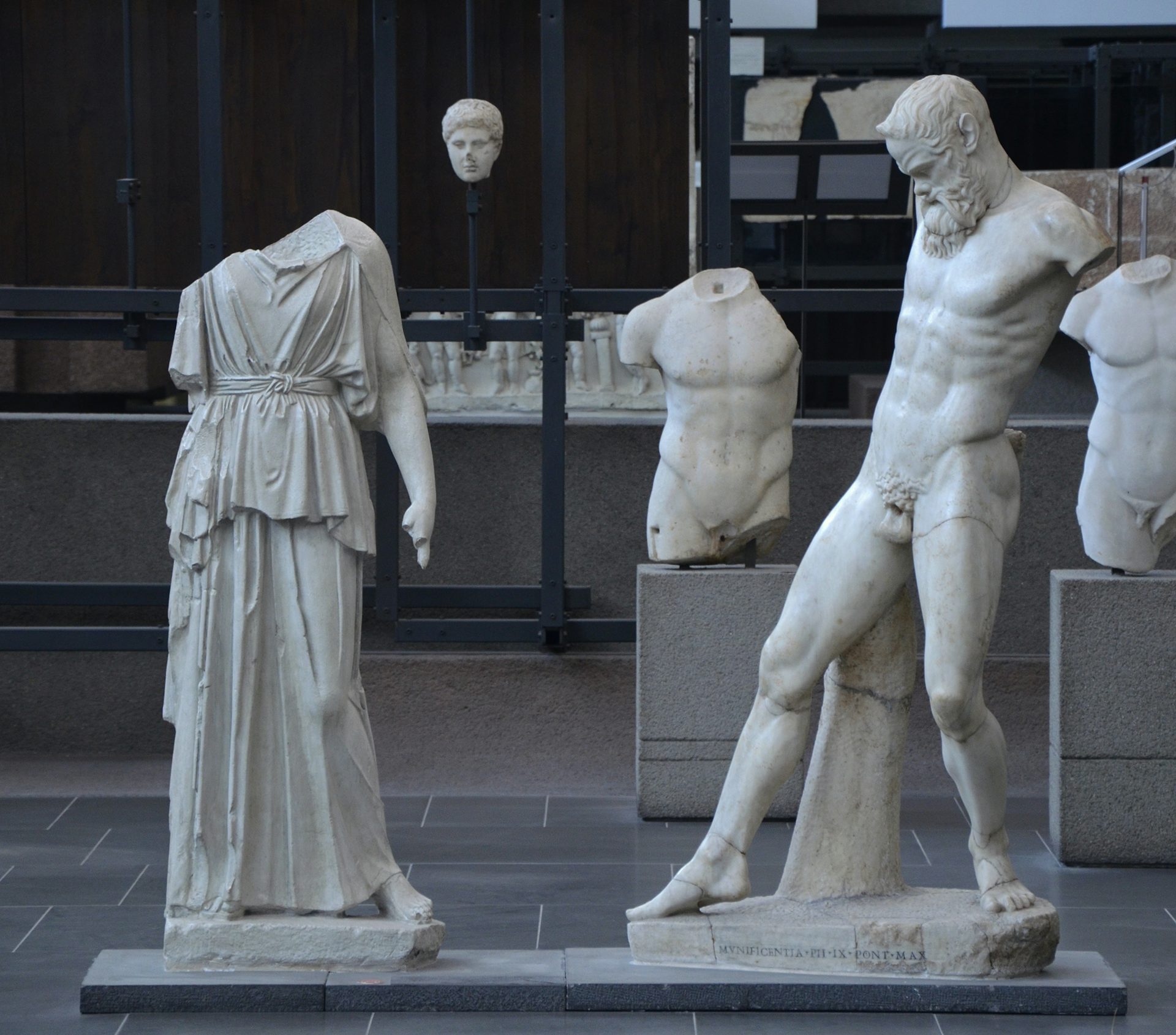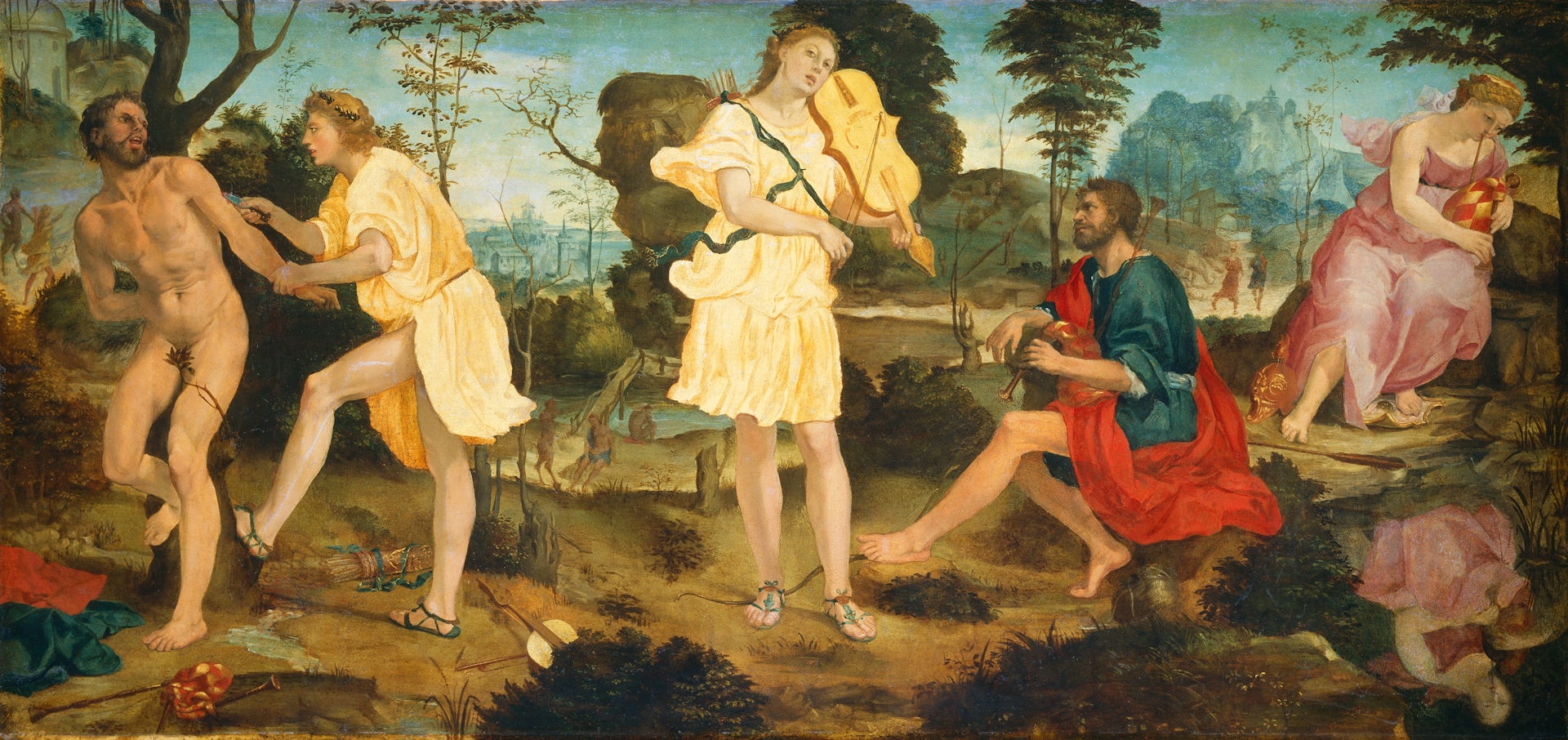Marsyas

The Young Marsyas Charming the Hares by Elihu Vedder (1878).
Crystal Bridges Museum of American ArtPublic DomainOverview
Marsyas was one of the satyrs (sometimes called silens), wild woodland creatures associated with the god Dionysus. He was known for his skill at playing the panpipes, an instrument invented—and then discarded—by the goddess Athena. Marsyas grew so confident in his musical abilities that he challenged Apollo, the god of music and inspiration himself, to a musical contest.
Apollo, of course, defeated Marsyas. He then exacted a savage punishment, exemplifying the jealous and petty nature of the Greek gods: he tied Marsyas to a tree and flayed him alive. It was said that Marsyas’ fellow woodland creatures wept a literal river for him—the River Marsyas.
Etymology
The etymology of the name “Marsyas” (Greek Μαρσύας, translit. Marsýas) is unknown. It bears a resemblance to the Greek word μάρσιππος (mársippos), meaning “bag, pouch, purse.” Though this word is also of uncertain origin, it may have come—like the mythical Marsyas—from ancient Asia Minor.[1]
Pronunciation
English
Greek
Marsyas Μαρσύας (translit. Marsýas) Phonetic
IPA
[MAHR-see-uhs] /ˈmɑr si əs/
Attributes
Locales
Marsyas was described as either a satyr or a silen, terms that were generally interchangeable in ancient Greece. He lived in Phrygia, near Celaenae and the source of the Meander River.[2]
Appearance and Abilities
Like the rest of his kind, Marsyas had the ears, tail, and possibly legs and coat of a horse (though in later times, satyrs and silens were represented with goat features instead).
Marsyas was one of the great musicians of Greek mythology. In the common tradition, he either invented or adopted the panpipes.[3] Other traditions made him the inventor of the double pipe,[4] while some vase paintings showed him playing the cithara or lyre.[5] Marsyas’ panpipes were said to have floated across the sea after his death, where they were dedicated in the temple of Apollo at Sicyon (though the relic was already lost by the first century CE).[6] Another relic, the skin that Apollo flayed from Marsyas’ body, was said to be on display in Celaenae.[7]
In addition to being an accomplished musician, Marsyas was associated with religious cults in Phrygia, especially that of Cybele (also known as the Magna Mater, or “Great Mother”).[8]
Personal Characteristics
Like other satyrs, Marsyas was a playful, wild, and uninhibited creature. But he was also known for his arrogance, lack of forethought, and above all for what the Greeks called hybris (the origin of the English word “hubris”).[9] To the Greeks, hybris was a terrible thing: it referred to insolence towards the gods (which Marsyas displayed by challenging Apollo). He paid a terrible price for this hybris, becoming a cautionary tale for any who thought too highly of themselves.
Iconography
There was no consistent iconographic representation of Marsyas in ancient Greece; he was alternately shown as young and old, sometimes sporting shaggy hair or even the goat-like horns usually seen on Pan.
Marsyas’ myth first became popular in art around the fifth century BCE, perhaps following the composition of Melanippides of Melos’ dithyramb Marsyas. It was around this time that the sculptor Myron created a group of statues based on the myth for display on the Athenian Acropolis.[10]
Over time, sculptors, vase painters, and other artists increasingly represented Marsyas’ contest with Apollo in their works. They often included the judges, the musical instruments, and the tree and knife used for the flaying (reminders of the contest’s dire outcome).

Roman copy (first century CE) of a statue group by Myron (mid-fifth century BCE) representing the myth of Marsyas. Maryas (right) is shown discovering the panpipes that had just been discarded by Athena (left). Vatican Museums, Vatican, Italy.
Carole RaddatoCC BY-SA 2.0Later, the myth of Marsyas was inherited by Roman artists. There was even a statue of Marsyas with a wineskin on his shoulder in the Roman Forum (80 BCE or earlier). Marsyas and his myth also appeared on monuments, wall paintings, and coinage.[11]
Family
Family Tree
Parents
Fathers
Mother
- Hyagnis
- Olympus
- Oeagrus
- Nymph
Children
Son
- Olympus
Mythology
Origins
The ancient Greeks believed that the myth of Marsyas came from Celaenae in southern Phrygia, a town located by the Meander River. His skin, flayed by Apollo, was supposedly displayed nearby.[18]
But the myth may have also had a connection with the cult of Apollo. This is suggested not only by Apollo’s central role in the myth, but also by one strange account of Marsyas’ birth. According to Ptolemaeus Chennus, Marsyas was born on the day of a festival of Apollo, during which the flayed skins of sacrificed animals were displayed in honor of the god—a chilling portent of the satyr’s own impending fate.[19]
The Contest
The myth of Marsyas begins with the fateful invention of the panpipes. In the most familiar tradition, this instrument—made up of several hollow reeds of varying lengths—was invented by Athena, the goddess of wisdom. But when Athena caught a glimpse of her reflection while playing the panpipes—face strained, cheeks puffed out—she threw them away in disgust. According to some, she even put a curse on the instrument and whoever played it.[20]
Marsyas soon chanced upon the panpipes and quickly took to this strange instrument. In one myth, he played the pipes to scare off an army of Gauls when they came to attack Phrygia.[21] Eventually, Marsyas became so skilled that he wished to pit himself against Apollo, the most musical of the Olympian gods. Marsyas challenged Apollo to a music contest—his panpipes against Apollo’s lyre. The winner, they decided, could do whatever he liked with the loser.
Marsyas and Apollo prepared for the contest. They chose judges (depending on the tradition, the contest was judged by either the Muses, the Phrygian king Midas, the mountain god Tmolus, the people of the nearby city of Nysa, or, as sometimes in art, by Athena).
Though both Marsyas and Apollo played beautifully, Apollo was declared the winner. In one version of the story, he finally bested Marsyas by playing his lyre upside down and challenging Marsyas to do the same.[22] When Marsyas could not replicate the trick, he was defeated. In another version, Apollo won because he could play the lyre and sing at the same time, while Marsyas—who needed to use his mouth to play his instrument—could not.[23]

Apollo and Marsyas by Michelangelo Anselmi (ca. 1540).
National Gallery of ArtPublic DomainAfter he was declared the winner, Apollo inflicted a terrible punishment on Marsyas, wishing to make an example of him. Apollo bound Marsyas to a tree and flayed him alive (in some versions, he had a Scythian slave do the flaying for him). The tears shed by Marsyas’ friends (or, in other versions, the blood that poured from Marsyas’ body) became the River Marsyas, a tributary of the larger Meander.[24]
Apollo, meanwhile, claimed the skin of the poor Marsyas as his trophy and may have turned it into a wineskin.[25] But in one version of the story, Apollo regretted what he had done so much that he broke his lyre and never played again.[26] The myth of Marsyas became a famous example of the pettiness and cruelty often displayed by the Greek gods.
Happier versions of the Marsyas myth do exist. For example, the Roman epic poet Silius Italicus described how Marsyas fled to Italy after he was defeated by Apollo, becoming the ancestor of the Marsi, an ancient Italian people who lived near the Fucine Lake in central Italy.[27]
There are also vase paintings that show Marsyas playing the lyre rather than the pipes; this may imply a version of the myth in which the satyr was not flayed after his defeat but simply forced to admit the superiority of the lyre and give up his panpipes.[28]
Pop Culture
The myth of Marsyas and his terrible fate continues to captivate the modern imagination, serving as a striking illustration of the savagery often exhibited by the powerful. The myth has inspired many contemporary poets, including James Merrill, Zbigniew Herbert, Nadine Sabra Meyer, and Hugo Claus, as well as artists like Anish Kapoor.